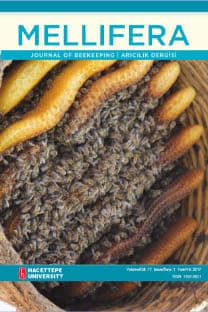Bursa yöresinden Apis mellifera L. tarafından toplanan ve ekonomik önemi olan polenlerin organoleptik analizi
2001 yılının Mayıs, Haziran, Temmuz, Ağustos ve Eylül aylarında, arıcılığın yoğun olarak yapıldığı Bursa'nın Cumalıkızık, Narlıdere, Akçalar, İkizce, Çekrice ve Baraktı bölgelerinden polen örnekleri toplanmıştır. Toplanan polenlerden anların miktar bakımından en çok topladığı 14 taksan polen, ekonomik olarak önemli olduğu gerekçesiyle organoleptik analizler için çalışılmaya uygun bulunmuştur. Mikroskop ile yapılan teşhisler sonucunda çalışılan polen taksonları Asteraceae familyasına ait, Carduus tip I, Carduus tip H, Helianthus annuus L. ve Xanthium strumarium L., Brassicaceae familyasına ait, Raphanus raphanistrum L., Cistaceae familyasına ait Cistus creticus L. ve Cistus salviifolius L., Dipsacaceae familyasına ait Cephalaria transsylvanica (L.) Schroder ve Scabiosa columbaria L., Fabaceae familyasına ait Trifolium pratense L. ve Trifolium repens L'., Fagaceae familyasına ait Castanea sativa Miller, Papaveraceae familyasına ait Papaver rhoeas L. ve Ranunculaceae familyasına ait Convolvulus arvensis L. olmak üzere toplam 8 familyaya ait 14 taksan tespit edilerek, organoleptik (tat, koku, renk) ve nişasta analizleri yapılmıştır. Fagaceae familyasına ait C. sativa, nişasta içermemesi ve tat ile koku değerlerinin en yüksek değeri alması nedeniyle en çok tercih edilen polen olmuştur. Asteraceae familyasına ait Carduus tip l ve Carduus tip II polenleri ile Ranunculaceae familyasına ait Convolvulus arvensis poleni nişasta içermeleri ve tat ile koku değerlerinin en az değeri alması nedeniyle tercih edilmeyen polen olarak tanımlanmıştır.
Organoleptic analysis of economically significant pollen samples collected in Bursa Region by apis mellifera L
Pollen samples were collected in May, June, July, August and September 2001 from Cumahkizik, Narlıdere, Akçalar, İkizce, Çekrice and Barakh areas of Bursa where intensive beekeeping activities take place. Among these pollen samples, 14 taxa that bees collect most were selected for organoleptic analysis for their economic significance. Microscopic analyses yielded 14 taxa belonging to 8 families as follows: Carduus type I, Carduus type II, Helianthus annuus L. and Xanthium strumarium L.from Asteraceae family, Raphanus raphanistrum L.from Brassicaceaefamily; Cistus creticus L. and Cistus salviifolius L.from Cistaceae family; Cephalaria transsylvanica (L.) Schrade and Scabiosa columbaria L. from Dipsacaceae family; Trifolium pratense L. and Trifolium repens L. from Fabaceae family; Castanea saliva Miller from Fagaceae family; Papaver rhoeas L.from Papaveraceae family and finally Convolvulus arvensis L.from Ranunculaceae family. These pollen samples were then subjected to organoleptic (taste, odour, colour) and starch analyses. C. sativafrom F agaceae family was the most preferred pollen for having no starch content and highest values of taste and odour. The pollen samples of Carduus type I and Carduus type II from Asteraceae family as well as Convolvulus arvensis from Ranunculaceae family were not preferred for their high starch content and low values of taste and odour.
___
- 1. Knox, R. B., Pollen and allergy, The Institute of Biology's Studies in Biology no.107, Edward Arnold, 1979.
- 2. Schmidt, J. O., Buchmann, S. L., The Hive and Honeybee, editor, J.Graham, Dadant and Sons, Hamilton, Illinois, 927-988, 1992.
- 3. Stanley, R. G., Linskens, H. F., Pollen: Biology, Biochemistry, Management. Springer-Ver lag : Berlin, Heidelberg, New York,82-115, 1974.
- 4.Bonvehi, S. J., Pajuelo, G. A., Galindo, G. J., Organoleptical tests of pollen loads, Apiacta 21: 15-20, 1986.
- 5. Sorkun, K., Balda nişasta analizi, Teknik Arıcılık, 78, 6-8, 2002.
- 6. Krell, R., Value-added products from beekeeping, Fao Agricultural Services Bulletin No: 124, Chapter 3, Pollen, http://www.fao.org/docrep, 1996.
- 7. Wodehouse, R. P., Pollen Grains, Me Graw, Hill N. Y., 106-109, 1935.
- 8.Aytuğ, B., Istanbul çevresi bitkilerinin polen atlası, İstanbul, 330, 1971.
- 9.D'Albore, G. R., Textbook of melissopalynology, Apimondia Publishing House, Bucharest, 308, 1997.
- 10. Erdtman, G., Handbook of palynology, Hafner Publishing Co., New York, 486, 1969.
- 11. Faegri, K., iversen, J., Textbook of pollen analysis, Ed.; Faegri, K., Kaland, P. E., Krzywinski, K., John Wiley & Sons, Chichester, IV Edition, 328, 1989.
- 12. Iwanami, Y., Sasakuma, T., Yamada, Y., Pollen: illustrations and scanning electronmicrographs, 191,1988.
- 13.Kapp, R. 0., Pollen and spores, 249,1971.
- 14.Markgraf V., D'Antoni, H. L., Pollen flora of Argentina, The University of Arizona Press, Tucson, Arizona, 208,1978.
- 15. Moore, P. D., Webb, J. A., Collinson, M. E., Pollen analysis, Blackwell Scientific Publications, London, U.K., 216, 1991.
- 16. Nilsson, S., Praglowski, J., Nilsson, L., Atlas of airborne pollen grains and spores in Northern Europe, Stockholm, 159, 1983.
- 17. Pehlivan, S., Türkiye'nin alerjen polenler atlası, Ünal Ofset, Ankara, 191,1995.
- 18. Bonvehi, S. J., Pajuelo, G. A., Evaluation of honey quality by organoleptical analysis, Apiacta, 23,103-108,1988.
- 19. Gonnet, M., Judging the quality of honey by sensory analysis, 247-251, in Bee Products Properties, Applications and Apitherapy, Edith by Avshalom Mizrahi, Yaacov Lensky, 1997, Plenum Press, New York, 269,1996.
- 20. Süer, B., Sorkun, K., Bursa'nın Narlıdere, Cumalıkızık ve Barakli yörelerinden Apis mellifera L. tarafından toplanan polenlerin organoleptik analizi, Mellifera, 6, 9-15, 2003.
- 21. Sorkun, K., Polende renk çeşitliliği, Teknik Arıcılık, 77, 13-14, 2002.
- 22. Sorkun, K., Şahin, A., The source of starch grains from Turkish pine honey, Journal of Apicultural Research 39(1-2): 85-86,2000.
- ISSN: 1302-5821
- Başlangıç: 2001
- Yayıncı: Hacettepe Üniversitesi
Sayıdaki Diğer Makaleler
İç Anadolu Bölgesi bazı bombus arısı (Bombus, Apidae, Hymenoptera) türlerinde allozim çeşitliliği
Neşe ÇAĞATAY, A. Murat AYTEKİN
Propolisin suda çözünür bir türevinin fareler üzerindeki radyoaktif etkisi
Nada ORSOLİC, Zoran TADİC, Vesna BENKOVİÇ, Mirko LOJKİC, Ivan BASİC, Anica HORVAT
Raşiv K. GUPTA, Ravindra k. NAVAL, Santosh K. CHARAN, Abhishek RAJPUROHIT
